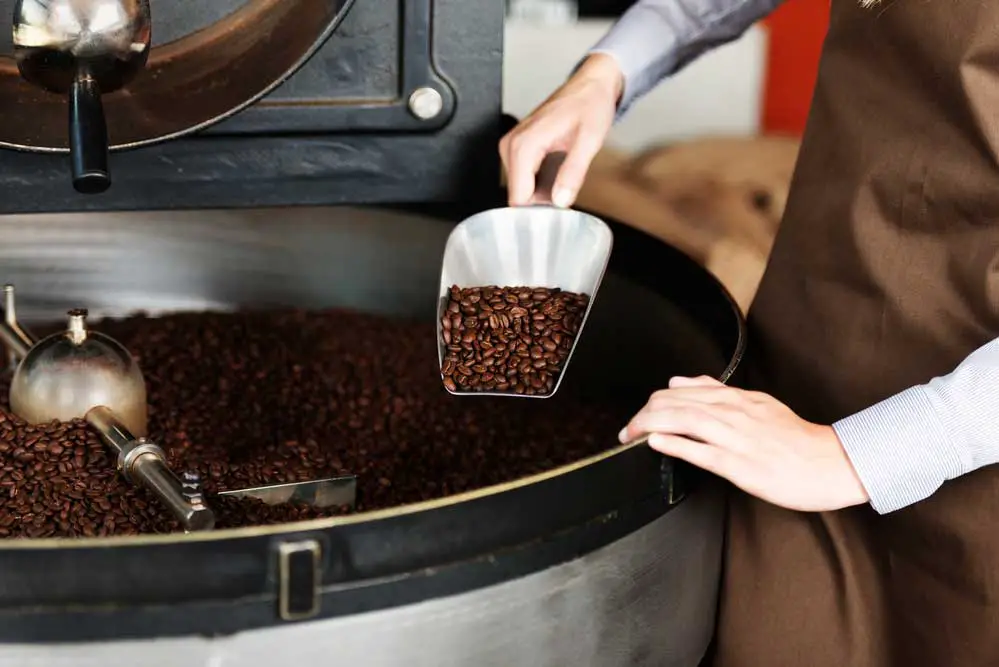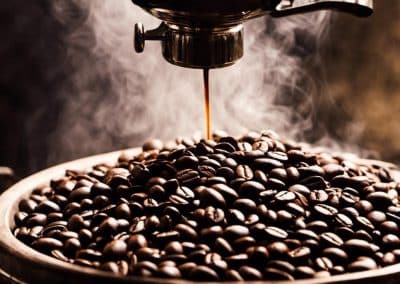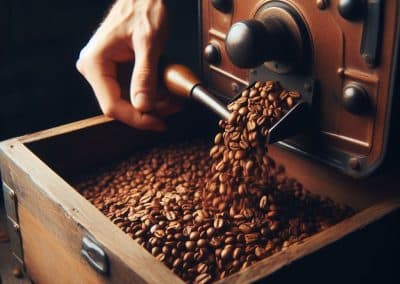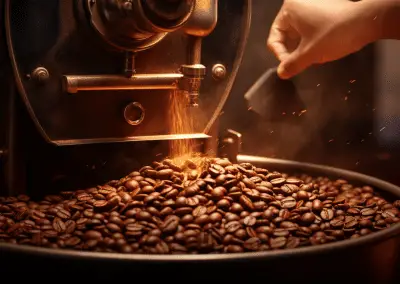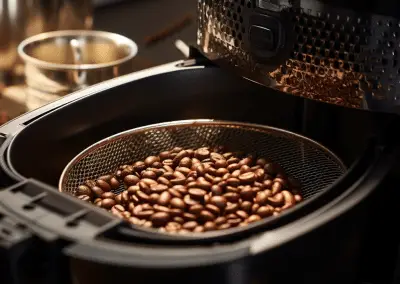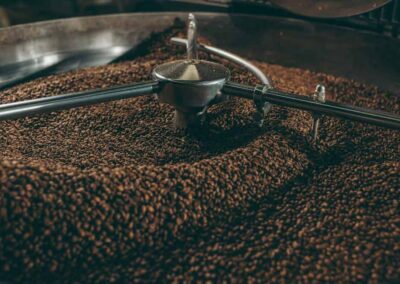Coffee roasting is an exciting topic that is generating a lot of buzz in the coffee industry. With innovations and trends shaping the future of coffee roasting, there is a lot to look forward to in terms of quality, sustainability, and taste. Coffee roasting is an art form that requires a delicate balance of temperature, time, and airflow to create the perfect roast. As technology advances, it is becoming easier for roasters to achieve this balance and produce high-quality coffee.
One of the biggest trends in coffee roasting is sustainability. Coffee producers and roasters are becoming more aware of the impact their operations have on the planet and are taking steps to reduce their carbon footprint. This includes using sustainable coffee beans, reducing waste, and investing in technology that reduces emissions. Additionally, coffee shops are looking for ways to reduce their environmental impact by using sustainable packaging and reducing energy consumption. As consumers become more environmentally conscious, the demand for sustainable coffee is expected to rise.
Another trend in coffee roasting is automation. With the help of machine learning and artificial intelligence, roasters can create a roasting profile that is tailored to their specific needs. Automated roasting also helps to reduce the risk of fire and smoke, creating a safer atmosphere for both the roaster and the planet. Infrared sensors and drum sensors are also being used to monitor the roasting process and ensure that the coffee is roasted to perfection. As technology continues to advance, the possibilities for coffee roasting are endless.
The Importance of Coffee Roasting
Coffee roasting is a crucial step in the coffee production process. It is the process of heating coffee beans to a specific temperature and duration, which brings out the unique characteristics of each bean. The roasting process is responsible for the aroma, flavor, and color of coffee.
Roasting coffee beans is an art form that requires a great deal of knowledge and skill. The roaster must understand the characteristics of each bean, such as its origin, altitude, and processing method, to bring out the best flavors. The quality of the roast is essential in producing high-quality coffee.
Roasting coffee is a complex process that involves several chemical reactions. The beans go through several stages, including drying, browning, and caramelization. The roaster must carefully monitor the temperature and duration of each stage to achieve the desired roast level.
The future of coffee roasting is exciting, with constant innovations and trends shaping the industry. Roasters are experimenting with new techniques, such as cold brew and nitro coffee, to produce unique flavors. Sustainability practices are also becoming more important, with roasters looking for ways to reduce waste and carbon emissions.
In conclusion, coffee roasting is a crucial step in the coffee production process that transforms green coffee beans into the aromatic, flavorful coffee that we know and love. The importance of quality roasting cannot be overstated, as it is responsible for the aroma, flavor, and color of coffee. The future of coffee roasting is bright, with constant innovations and trends shaping the industry.
Innovations in Coffee Roasting Technology
With the coffee industry constantly evolving, there are many technological innovations that are shaping the future of coffee roasting. In this section, we will explore some of the most significant advancements in coffee roasting technology.
Automated Roasting
One of the most significant technological advancements in coffee roasting is automation. Automated roasting technology allows for precise control over the roasting process, resulting in more consistent and high-quality coffee products. Automated roasting technology uses sensors and software to monitor and adjust the temperature, airflow, and other parameters of the roasting process. This technology can also provide real-time data on the roast, allowing the roaster to make adjustments on-the-fly.
Machine Learning and Artificial Intelligence
Machine learning and artificial intelligence (AI) are also playing a significant role in the future of coffee roasting. These technologies can analyze data from the roasting process to optimize the roast profile and improve the quality of the coffee. For example, AI technology can analyze the progress of a single bean throughout the roast and automatically adjust temperature and airflow when the data indicates that it’s time to do so. This can result in a more consistent roast and a better-quality coffee.
Infrared Sensors
Infrared sensors are another technological innovation that is shaping the future of coffee roasting. These sensors can measure the temperature of the coffee beans during the roasting process, providing a more accurate and precise measurement than traditional thermocouples. This technology can also provide real-time data on the roast, allowing the roaster to make adjustments on-the-fly.
In conclusion, the future of coffee roasting is bright, with many technological innovations shaping the industry. Automated roasting, machine learning and artificial intelligence, and infrared sensors are just a few of the advancements that are making coffee roasting more precise and consistent. As the industry continues to evolve, we can expect to see even more technological innovations that will shape the future of coffee roasting.
Sustainable Coffee Roasting Practices
As the coffee industry continues to grow, sustainable coffee roasting practices are becoming increasingly important. Coffee roasting is a significant contributor to carbon emissions, waste, and energy consumption. In response, many coffee roasters are adopting sustainable practices to reduce their environmental impact.
Reducing Emissions
One of the most significant environmental challenges of coffee roasting is the emission of greenhouse gases. Roasting coffee beans requires high temperatures, which often come from burning fossil fuels. To reduce emissions, many coffee roasters are turning to electric roasters and renewable energy sources. For example, Bellwether Coffee is a California-based company that uses electric heating elements in their roasters, reducing emissions by up to 90% per roasting cycle.
Waste Management
Coffee roasting generates a significant amount of waste, including coffee chaff, packaging materials, and used coffee grounds. Sustainable coffee roasters focus on reducing waste and finding innovative ways to repurpose it. For example, some coffee roasters use coffee chaff as a natural fertilizer for their coffee plants, while others donate used coffee grounds to local farmers for composting.
Carbon Footprint
Sustainable coffee roasting practices also focus on reducing the carbon footprint of the coffee supply chain. This includes everything from sourcing green coffee beans from sustainable farms to using energy-efficient roasting equipment. By reducing the carbon footprint of coffee roasting, sustainable coffee roasters can help mitigate climate change and ensure the long-term viability of the coffee industry.
In conclusion, sustainable coffee roasting practices are essential for the future of the coffee industry. By reducing emissions, managing waste, and minimizing the carbon footprint of coffee roasting, coffee roasters can help create a more sustainable and environmentally friendly coffee supply chain.
Trends in Coffee Roasting
The coffee industry is constantly evolving, and coffee roasting is no exception. Innovations and trends are shaping the future of coffee roasting, and it’s important to stay up-to-date with the latest advancements. In this section, we’ll explore some of the most significant trends in coffee roasting.
Roasting Trends
One of the most significant trends in coffee roasting is the use of technology. Roasting machines are becoming more sophisticated, allowing for greater control over the roasting process. This means that roasters can fine-tune their roasting profiles to achieve specific flavor profiles and ensure consistency in their products.
Another trend in coffee roasting is the use of sustainable practices. Many coffee roasters are taking steps to reduce their environmental impact by using renewable energy sources, reducing waste, and sourcing coffee beans from sustainable farms.
Flavor Trends
Flavor is a crucial aspect of coffee, and there are several flavor trends that are shaping the future of coffee roasting. One trend is the use of single-origin coffee beans. Single-origin coffee beans are sourced from a specific region or farm, and they offer unique flavor profiles that are distinct from blends.
Another flavor trend is the use of lighter roasts. Lighter roasts are becoming increasingly popular because they allow the natural flavors of the coffee beans to shine through. This trend is particularly prevalent in specialty coffee shops, where customers are looking for unique and complex flavor profiles.
In conclusion, the future of coffee roasting is being shaped by a variety of trends and innovations. From the use of technology to sustainable practices and unique flavor profiles, coffee roasters are constantly pushing the boundaries of what’s possible. As the industry continues to evolve, it’s important to stay up-to-date with the latest trends to ensure that your coffee roasting business remains competitive and successful.
The Future of Coffee Roasting
As the coffee industry continues to grow, coffee roasting is becoming an increasingly important aspect of coffee production. Innovations in technology, sustainability practices, and flavor profiles are driving the industry forward. In this section, we’ll explore some of the trends and innovations shaping the future of coffee roasting.
Air Roasting
One prediction for the future of coffee roasting is that air roasting will continue to gain popularity. Air roasting is a method that uses hot air to roast coffee beans, rather than a heated surface. This method allows for a more even roast and can produce a cleaner, brighter cup of coffee. Air roasting also produces less smoke and reduces the risk of fire.
Cold Brew Roasting
Another trend in coffee roasting is the rise of cold brew roasting. Cold brew coffee is becoming increasingly popular, and roasters are adapting their methods to create beans specifically for cold brew. Cold brew roasting involves roasting the beans at a lower temperature for a longer period of time, which can result in a smoother, less acidic cup of coffee.
Drum Roasting
Drum roasting is a traditional method of coffee roasting that has been used for centuries. While newer methods like air roasting and cold brew roasting are gaining popularity, drum roasting is still widely used and will likely continue to be used in the future. Drum roasting involves roasting the beans in a rotating drum, which allows for a more consistent roast and can produce a fuller-bodied cup of coffee.
Sustainability and Technology
As coffee producers and consumers become more environmentally conscious, sustainability practices in coffee roasting are becoming increasingly important. Roasters are implementing new technologies to reduce waste and energy consumption, such as using solar power and recycling coffee chaff. Additionally, roasters are focusing on sourcing beans from sustainable and ethical sources.
In conclusion, the future of coffee roasting is shaped by a combination of traditional methods and innovative technologies. Air roasting, cold brew roasting, and drum roasting are all methods that will likely continue to be used in the future. As sustainability practices become more important, roasters will continue to implement new technologies to reduce waste and energy consumption.
The Impact of Coffee Roasting on Coffee Shops and Sales
Brewing Methods and Espresso Machines
As coffee roasting continues to evolve, so do the brewing methods and espresso machines used in coffee shops. With the rise of specialty coffee, customers are becoming more discerning about the brewing methods used to make their coffee. Espresso machines are also becoming more advanced, with features like temperature control and pressure profiling that allow for greater precision in the brewing process.
Roasting Profiles and Specialty Coffee
Roasting profiles have a significant impact on the flavor and aroma of coffee. As more coffee shops focus on specialty coffee, they are experimenting with different roasting profiles to create unique flavor profiles. This has led to the rise of small-batch roasting, which allows coffee shops to offer a wider variety of coffee with distinct flavor profiles.
Sensors and Sales
Advancements in technology have led to the development of sensors that can monitor the roasting process in real-time. This allows roasters to make adjustments to the roasting profile as needed, resulting in more consistent and higher quality coffee. This technology has also led to the rise of direct trade, where coffee shops can work directly with farmers to source high-quality coffee beans. This has a positive impact on both the farmers and the coffee shops, as it allows for greater transparency and sustainability in the coffee supply chain.
Overall, the impact of coffee roasting on coffee shops and sales is significant. With the rise of specialty coffee and the increasing importance of sustainability, coffee shops are adapting to meet the changing demands of their customers. By embracing new brewing methods, investing in advanced espresso machines, experimenting with roasting profiles, and utilizing sensors to monitor the roasting process, coffee shops are able to offer high-quality coffee that meets the needs of their customers while also supporting sustainable practices in the coffee industry.
Conclusion
As coffee continues to gain popularity around the world, the roasting industry is constantly evolving to meet the needs and preferences of consumers. From technological advancements to sustainable practices, there are a variety of emerging trends that are shaping the future of coffee roasting.
One trend that is likely to continue is the use of automation and computerization in the roasting process. This allows for more precise control over the roasting process, resulting in consistent and high-quality coffee products. Additionally, sustainable coffee roasting practices are becoming increasingly important as consumers become more conscious of their impact on the environment.
Another trend that is expected to shape the future of coffee roasting is the development of new flavor profiles. Roasters are experimenting with different beans and roasting techniques to create unique and exciting flavor combinations that appeal to a wider range of consumers.
Overall, the future of coffee roasting looks bright as the industry continues to innovate and evolve. As consumers become more discerning and demand higher quality products, roasters will need to continue to adapt and experiment to stay ahead of the curve. For more articles, click HERE.

